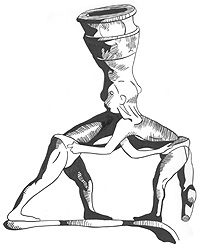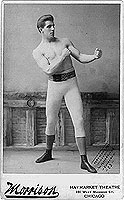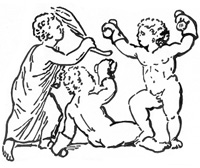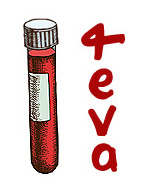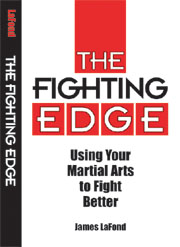Hello James,
My name is Richard Barrett, and I'm a big fan of your work. I'm 24 years old, have written and published 3 books, starting working out 3 1/2 years ago, and am currently working on getting my Blue Belt in Jiu-Jitsu.
My [redacted] and because of his job, I have gotten to live all over the country, have had some unique experiences, and gotten to meet some interesting people. I can tell you, I agree with almost everything you write! It's pretty clear you're the real deal.
From fight gym scams to dealing with people of a different color or creed than you, from situational awareness to dealing with evil (and good!) women, and on top of it all, the truth that is found in Pulp Fiction, you hit the nail on the head.
I am the Chief Editor of The Mind At War (which is a fancy way of saying that I am the only real writer on the site!), though these days I am more active on Instagram, and my books are available on Amazon.
My first book, The Forgotten History of World War I: From the Dark Ages to 1939, examines differing British and German tactical doctrines and how these influenced the outcome of the war. It is like no other WWI book out there, in the fact that I rejected almost every popular history of the war as my source, and got deep into the academic specialist literature on the topic in a way I hadn't seen done before. It's written in a no-holds-barred, jingoistic, chest-thumping, pulp/propaganda style.
(On deciding on the tone, I read an old Blackhawk comic from 1957 I got from an antique store, and decided that was the way I was going to write it, with descriptive paragraphs filling in for comic panels).
My second book, All Men Follow the Strongman: The Forgotten History of the Iraq War, is of a much more measured, academic tone. It charts the history of Arabic Bedouin warfighting culture from the pre-Mohammad days in the Arabian Peninsula, it's influence on Mohammad's formation of Islam, how the British and French Imperialist operators dealt with this culture, and how their lessons were rediscovered during the 2003-2011 Iraq War.
As far as my knowledge goes, it is the second most in-depth analysis of Saddam's Hussein's ideology of Baathism (at the time of writing, I owned every book about Saddam written in English with the exception of 3 or 4, which I rented from the library, and as far as I am aware, I am the only non-specialist writer to use the open access Saddam Hussein files housed digitally and physically at the Woodrow Wilson Institute of Peace in DC). It is also the only book in English to extensively quote the ideologically writings of Michel Aflaq, Saddam Hussein's mentor, role model, and founder of Baathism.
Finally, my third book is called Go Make America Great Again! and is a campaign tract I wrote for the 2016 campaign. I do not believe that Donald Trump can solve all of our problems (they're too deeply rooted in Academia, Philosophy, and the Arts and Entertainment to be solved by one man), but I believe that tactically, you want to buy as much time for yourself as possible to prepare yourself for the inevitable time when every city and town in America becomes like Baltimore.
This year, I am working on two new books. The first one has a working title of Return of the Strongman: Reawakening the Warrior Culture of the West. I plan on examining all of the facets that made up the Western warfighting ethos...from Old Testament Hebraic warfighting attitudes, to Greco-Roman and Stoic doctrines, to the Ancient Germanic/Arayan/Anglo-Saxon attitudes. I then plan on comparing them to an area that is my baseline, Arabic Bedouin warfighting culture.
My thesis, garnered from your writings, is that Western warfighting culture (i.e. European) is primarily confrontational...Marshall Dillon goes out into the town in his white hat, the black-hatted bandit meets him on the opposite end of the street, they draw fast, and Matt Dillon blows the bad guy away.
I compare this to Third World warfighting culture (African, Asian, Arab, and American Indian), which is primarily predatory. This is a dichotomy I have garnered from your writings on the African-American combat culture of the inner-cities, which is extremely similar to Arabic Bedouin warfighting culture.
It seems to me that in a Confrontational Culture, shooting fish in the barrel is the mark of a coward, because the fish cannot possibly shoot back. But in a Predatory Culture, shooting fish in the barrel is the mark of a man, because it highlights your blatant superiority over the fish in a ritualized sacrifice, with oneself as the chief priest.
I know you have a new book finished, The Sons of Arayas, and from what I can gather on your site, it is not available yet. Are you interested in advanced readers? If you are, I would love to be one, given that it seems you have covered a lot of the territory that I am now entering. My knowledge and bibliography of Old Testament Hebraic warfighting attitudes is quite extensive, and my Greco-Roman knowledge is decent (outlined essentially here, here, and here), and my research track to improve it is steady. However, Germanic/Arayan/Anglo-Saxon warfighting culture is a new field of study for me.
My sources I am going through right now are the classic Germania by Tacitus and The Culture of the Teutons by Vilhelm Gronbeck. There is a blogger who goes by the internet nom-de-guerre of John Mosby. He's a retired Green Beret who is friends with Jack Donovan, and has a Master's in Ancient Germanic History and extensive experience downrange with warrior tribes of Afghanistan and Iraq. He has a great bibliography on his website, as well as some interesting books of his own.
Maybe you have already addressed my thesis in a more limited format before The Sons of Arayas? If so, in which of your books have you done so? So far of your writings, I have read Don't Get Boned, When You're Food: Raw, Rubbing Out Pale Faces, The Punishing Art, and Being a Bad Man in a Worse World, and I have listened to almost all of your podcasts with the guys from The Myth of the Twentieth Century website (the one on White Slavery is the only one I have left to listen to). I have also recently ordered The First Boxers, The Combat Space, and Thriving in Bad Places.
My second book is also one I think you will like. It is on the history of exercise, strength and conditioning, with an emphasis on the 19th Century systems like Henrik Philip Ling's "Swedish Drill" system as well as Vladislav Krayevsky's system and "Professor Atilla's" system and their influence on Western Military PT programs, and their civilian use before being overtaken by bodybuilding and powerlifting in the 1970s. I am co-writing it with a good friend of mine named Ben Patrick, the "Knees Over Toes Guy", who has a training company called The Athletic Truth Group that specializes in bringing these types of programs back. With them, he has rehabbed himself from 14 knee surgeries before age 18, went from a 19 inch vertical to a 42 inch vertical, and has successfully rehabbed multiple NBA, NFL, and pro-Rugby guys.
I look forward to your response. Until then, I will continue to enjoy writings in print and on the web. You are one of the few people that combine all my favorite passions into one place!
Keep on keeping on.
Sincerely,
Richard Barrett
Wow, Richard, when I was your age I was reading history, fantasy and science-fiction, slaving away 75-hours a week at a grocery store, convinced that I would never fight again except in a losing effort against the outrunners of a Bantu Impi wondering why my wife hadn’t had sex with me in four years and hoping that one day I’d be able to write good enough to get a wargame on the Battle of Hastings published. I know have a sneaking suspicion that I’ll only be remembered by posterity, like Pytheus the Greek, based on you mentioning me in your footnotes somewhere.
I only write history because some folks have asked me too and because after I found out I was born and raised on an unmarked mass grave, I couldn’t look away from Plantation America anymore. My greatest thrill as a writer is having younger, smarter and less darkly-minded writers interested in my work.
I am not online and took this email down in a copy and paste and am commenting on it in my drop-cloth Yurt in a Portland garage. The final paragraph will be something I tack on at the bar this afternoon after I finally get to your site.
Currently my eye-saving policy is that I only read Robert E. Howard, primary history sources and stuff written by my readers.
To your main question on warfare, I see three types, where everyone else sees two.
Predatory warfare and confrontational warfare are best contrasted by Keely in War before Civilization.
Predatory warfare is simply based on the hunt.
Confrontational Warfare is a based on slavery of agricultural and industrial labor and a fight for the possession of the labor pool and the resources it develops for consumption. Victor Davis Hanson, in his books Wars of the Ancient Greeks and a War Like No Other, does a very good job of delineating the geneses of confrontational land-taking in the western conscience.
Except in extreme situations, these two types of warfare are unable to impact each other decisive [1] through direct action, and the civilized confrontational warrior will use his technology to destroy the hunter’s habitat and/or use his advanced industrial capacity to change, to become a special operations soldier, to become a better, airborne hunter, flying in by night seeing in the dark like a cat, and even remotely hunting with machines.
A third type of warfare I see as being based, not on hunting or farming, and being pre-modern, not on industry either, that being “confrontational predation” based on herding. Here, the herdsmen, still a hunter and still of predatory mind, uses his hunting knowledge to herd, to predict the fear response of herbivores and put them in an operational noose—like the Blitzkrieg would later do with tanks and planes. This nomad herdsman, does not live on hunting or faring but does desire to maintain his hunting identity and also gain the booty and comforts and soft slave women of the farming matrix. Whether he is Scythian, Dacai, Hun, Magyar, Cumin, Alan, Vandal, Lombard, Pencheneg, Turk, Tartar, Mongol or Comanche—or the prehistoric Arуan war bands who used hunting and herding methods to slaughter agrarian and archaic European men and enslave their women—who, like Delilah maintained their ability to weaken their men and betray them to others-this is the kind of warrior I have fallen to study, as I see him in glimpses and wonder.
Your work on pre-Islamic Semitic and Biblical warfare seems to offer an interactive look at this phenomenon. If only in desperation, the Chosen People, like the Sea Peoples of the Bronze Age Collapse appear to have operated as nomadic forces who did not live by the hunt, but were sustained by livestock. Chambers in his book The Devil’s Horseman, and Keegan in his History of Warfare, point out that the Mongol method of victory was only confrontational in appearance and used the cunning of the hunter to herd the enemy into killing zones. They even practiced “great hunts” in which they killed everything on four-legs in a given wilderness zone as practice for war—not by stealth, but by fear, driving the doomed before them.
This piece has run overlong, Richard. So I will devote another one to my reading of your site.
The first advance reading has been done on Sons of Aryas. When Lynn has it cleaned up and formatted sometime late this year, I’ll have her send you a copy.
Thank you.
link › mindatwar.org



